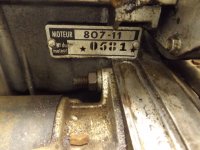Current:
Has electronic ignition.
I usually dynamically time older vehicles with a vacuum gauge, as I have done on this vehicle, after initial static timing.
Purchased a new EQUUS professional timing light this week & when the vacuum advance is plugged @ 650RPM idle hot I get what looks like 2 pointers showing @ extremes of the bell housing window, one looks painted.
With vacuum advance hooked in the painted pointer runs in the centre of the window
Background:
This engine & transmission is fitted to a 1949 Traction Avante [Slough Light 15]
It appears this engine was originally fitted with an auto transmission but the OP couldn't get the transmission to fit so reverted to the R16? 4 speed including bell housing.
Not sure about the clutch & flywheel but the standard R16 clutch was apparently not correct.
When I ordered a new clutch & pressure plate the old guy Wayne @ Better Brakes Southport [now retired] said that my sample was not R16 but here ~ this one is what y'all need & he had NOS on the shelf. So I really don't know what it's off but it would be French.
The bell housing window has 0 -2- 5 BTDC markings.
It is possible these bell housing markings although good with the pointer as far as degrees go & these indicating markings may not be too relevant to timing on this engine
I do have 3 X R16 manuals & have searched the internet, but can't find much info on the 807 - 11 engine.
The vacuum & mechanical advance seem to be fine.
Questions:
1. What are the 2 pointers for?
2. What degrees should the timing be @ 650RPM plugged vacuum advance line.
Many thanks,
John
Has electronic ignition.
I usually dynamically time older vehicles with a vacuum gauge, as I have done on this vehicle, after initial static timing.
Purchased a new EQUUS professional timing light this week & when the vacuum advance is plugged @ 650RPM idle hot I get what looks like 2 pointers showing @ extremes of the bell housing window, one looks painted.
With vacuum advance hooked in the painted pointer runs in the centre of the window
Background:
This engine & transmission is fitted to a 1949 Traction Avante [Slough Light 15]
It appears this engine was originally fitted with an auto transmission but the OP couldn't get the transmission to fit so reverted to the R16? 4 speed including bell housing.
Not sure about the clutch & flywheel but the standard R16 clutch was apparently not correct.
When I ordered a new clutch & pressure plate the old guy Wayne @ Better Brakes Southport [now retired] said that my sample was not R16 but here ~ this one is what y'all need & he had NOS on the shelf. So I really don't know what it's off but it would be French.
The bell housing window has 0 -2- 5 BTDC markings.
It is possible these bell housing markings although good with the pointer as far as degrees go & these indicating markings may not be too relevant to timing on this engine
I do have 3 X R16 manuals & have searched the internet, but can't find much info on the 807 - 11 engine.
The vacuum & mechanical advance seem to be fine.
Questions:
1. What are the 2 pointers for?
2. What degrees should the timing be @ 650RPM plugged vacuum advance line.
Many thanks,
John

